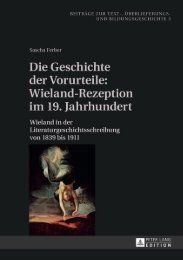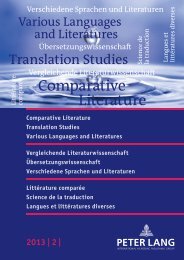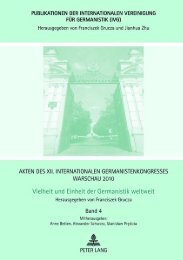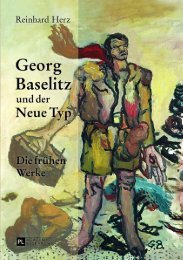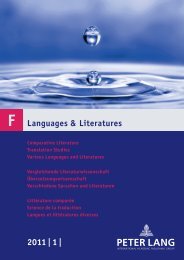Extract (PDF) - Peter Lang
Extract (PDF) - Peter Lang
Extract (PDF) - Peter Lang
You also want an ePaper? Increase the reach of your titles
YUMPU automatically turns print PDFs into web optimized ePapers that Google loves.
2 Fernanda Peñaloza<br />
authors, but particularly Chatwin in his acclaimed In Patagonia, also speculated<br />
about the origin of the word that gave name to the region (Chatwin<br />
92–94; Chatwin and Theroux 36–39). The writers refer at length to the<br />
controversial issue of the word “Patagonia”. For many years it was thought<br />
that Patagonia came from the Spanish pata, which literally means paw, but<br />
can be used colloquially as the equivalent of foot.<br />
The supposition behind this interpretation is that when Magellan saw<br />
the Tehuelches, he was amazed by the size of their feet, and called them<br />
“Big-Foot”, that is “Patagón”.3 According to María Rosa Lida de Malkiel,<br />
the name did not come from the big footprints of the Tehuelches but<br />
from the pages of Primaleon of Greece, which is the English title for the<br />
translated version of one of several sequels to the medieval sagas Amadís of<br />
Gaul (321–323). Since the book was published in Spain seven years before<br />
Magellan’s trip, it is very likely that the Portuguese explorer read or knew<br />
about the terrifying beast called Patagón that appeared in it.4 The 1596<br />
English translation by Anthony Mundy, a supposed friend of Shakespeare’s,<br />
led to more speculation. According to this genealogy, the fact that The<br />
Tempest was published fifteen years after the English translation of Amadís<br />
indicates that Shakespeare found in the monster Patagón a model for Caliban.5<br />
Shakespeare also used two other texts to create Caliban’s evil deity:<br />
3 For a study of the myth of the giants from this perspective see Percy G. Adams.<br />
Travelers and Travel Liars 1660–1800. Berkeley: University of California Press, 1962.<br />
Chap. II.<br />
4 I have consulted the 1619 publication of Primaleon of Greece translated into English<br />
from French and Italian. In The Second Book, Primaleon, the hero of the saga, meets<br />
the Grand Patagón. Chapter XXXIII opens with a dialogue between Primaleon<br />
and Palantine that takes place while they are hunting: “I heare great marveiles of ye<br />
(Sir) answered Primaleon, truly I would gladly see a monster so admirable: never<br />
disire the fight of him, replied Palantine, for in sooth ye mere better see the Divell,<br />
than Patagón” (255). Even though the connection between Primaleón of Greece and<br />
Pigafetta’s chronicle might be difficult to prove, textualised Patagonia never seems<br />
to disappoint a reader willing to find analogies.<br />
5 Shakespeare drew heavily from tales of the “New World”, and in a two-way exchange<br />
of meanings, his Latin American readers borrowed heavily from his work as well.<br />
The most famous Latin American essay on aesthetic and philosophical sensibilities




